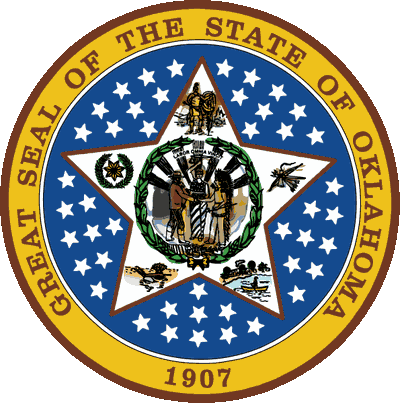

Oklahoma Symbols
- » 50 States
- » Histories
- » State Symbols
- » Seals
Oklahoma State Seal
Great Seal of the State of Oklahoma

Adopted in 1905.
The Great Seal of the State of Oklahoma consists of a five-pointed star in a circle. According to a statute adopted in 1957, the flag of the governor of Oklahoma consists of a forest green field, fringed in gold, charged with the state seal surrounded by a pentagram of five white stars. The seal was adopted by the 1905 constitutional convention of the proposed state of Sequoyah. Sequoyah, named for the inventor of the Cherokee syllabary, was a bid for statehood by Indian Territory, which comprised the eastern half of present-day Oklahoma
Oklahoma Great Seal
The Great Seal of the State of Oklahoma represents Oklahoma's unique place in American history and its melding of cultures.
The center of the star contains the seal of the original Territory of Oklahoma. In the center of the star is the image of an American Indian shaking hands with a white man under the watchful eye of Themis, the symbol of justice, symbolizing the joining of Oklahoma Territory and Indian Territory, as well as the joining of the cultures. Both are surrounded by olive branches, an old symbol of peace, under the state motto: Labor Omina Vincit, Labor Conquers All.
On each arm of the star is the symbol of one of the Five Civilized Tribes:
- the Choctaw Nation s in the upper right-hand ray. It consists of an unstrung bow with three arrows and a pipe-hatchet blended together. The ceremonial pipe-hatchet was passed around and smoked in council when deliberating important tribal matters. Though a peaceable people, the Choctaws were noted for great strength in defending their homes and country. The unstrung bow represents peace yet instant preparedness for defense. The three arrows, always ready, stood for the three great Choctaw chiefs.
- the Cherokee Nation is in the upper left-hand ray. It consists of a large, seven-pointed star surrounded by a wreath of oak leaves. The seven-pointed star represents the seven ancient clans of the Cherokee people. The wreath of oak leaves refers to oak wood, the principal hardwood in the old Cherokee country in the Carolinas that was used in maintaining the perpetually burning sacred fire. In this connection, oak was a symbol of strength and everlasting life.
- the Chickasaw Nation is in the top ray. It consists of an Indian warrior standing in ancient regalia, carrying two arrows in his right hand, a long bow in his left, and a shield on his left shoulder. The two arrows represent his guard over the two ancient tribal divisions, from which all Chickasaw clan and house names originated. According to old tribal lore, the bow and the shield represent the insignia of the Chickasaw warrior by right of his descent from the "House of Warriors".
- the Creek Nation is in the lower left-hand ray. It consists of a sheaf of wheat and a plow. The plow and sheaf of wheat were chosen as modern symbols of agricultural industry, for which the Creeks were noted from earliest times. It is a reference to the prosperity that agriculture brought to the Creek people.
- the Seminole Nation is in the lower right-hand ray. It consists of a plumed tribesman shown paddling a canoe across the lake to a village with a trading post standing near the shore. This scene represents some of the early customs surrounding the act of gathering, preserving and trading plants that were held sacred in connection with their ancient tribal religious rites and ceremonies. It is symbolic of peace and plenty.
Inside the gold ring which forms the border of the seal are the words "Great Seal of the State of Oklahoma," for that is what it is, and the year "1907," representing the year of admittance into the Union. The Great Seal was adopted in 1906.
Within this border, on a blue background, is a large five-pointed star. The five-pointed star was chosen because this is the American star, as seen on the US Flag. Since Oklahoma was the 46th state, 45 stars representing the other states are arranged in groups of nine between the arms of the star
Constitution of the State of Oklahoma, Article VI, Section 35.
Article VI: EXECUTIVE DEPARTMENT
Section VI-35: Description of seal.
In the center shall be a five pointed star, with one ray directed upward. The center of the star shall contain the central device of the seal of the
Territory of Oklahoma, including the words, "Labor Omnia Vincit." The upper left hand ray shall contain the symbol of the ancient seal of
the Cherokee Nation, namely: A seven pointed star partially surrounded by a wreath of oak leaves. The ray directed upward shall contain the symbol
of the ancient seal of the Chickasaw Nation, namely: An Indian warrior standing upright with bow and shield. The lower left hand ray shall contain
the symbol of the ancient seal of the Creek Nation, namely: A sheaf of wheat and a plow. The upper right hand ray shall contain the symbol of the ancient
seal of the Choctaw Nation, namely: A tomahawk, bow, and three crossed arrows. The lower right hand ray shall contain the symbol of the ancient seal
of the Seminole Nation, namely: A village with houses and a factory beside a lake upon which an Indian is paddling a canoe. Surrounding the central
star and grouped between its rays shall be forty-five small stars, divided into five clusters of nine stars each, representing the forty-five states
of the Union, to which the forty-sixth is now added. In a circular band surrounding the whole device shall be inscribed, "GREAT SEAL OF THE STATE
OF OKLAHOMA 1907."






